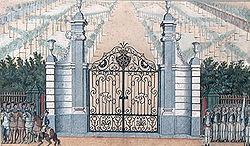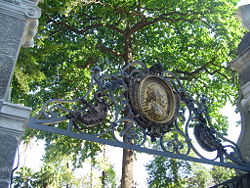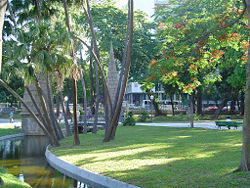
Passeio Público
Encyclopedia

Park
A park is a protected area, in its natural or semi-natural state, or planted, and set aside for human recreation and enjoyment, or for the protection of wildlife or natural habitats. It may consist of rocks, soil, water, flora and fauna and grass areas. Many parks are legally protected by...
in the historic centre of Rio de Janeiro
Rio de Janeiro
Rio de Janeiro , commonly referred to simply as Rio, is the capital city of the State of Rio de Janeiro, the second largest city of Brazil, and the third largest metropolitan area and agglomeration in South America, boasting approximately 6.3 million people within the city proper, making it the 6th...
, Brazil
Brazil
Brazil , officially the Federative Republic of Brazil , is the largest country in South America. It is the world's fifth largest country, both by geographical area and by population with over 192 million people...
. Built after 1779, it is the oldest public park of Brazil and one of the oldest in the Americas
Americas
The Americas, or America , are lands in the Western hemisphere, also known as the New World. In English, the plural form the Americas is often used to refer to the landmasses of North America and South America with their associated islands and regions, while the singular form America is primarily...
.
History
In 1763, the seat of government of colonial BrazilColonial Brazil
In the history of Brazil, Colonial Brazil, officially the Viceroyalty of Brazil comprises the period from 1500, with the arrival of the Portuguese, until 1815, when Brazil was elevated to kingdom alongside Portugal as the United Kingdom of Portugal, Brazil and the Algarves.During the over 300 years...
was transferred from Salvador de Bahia to the city of Rio de Janeiro. Among other improvements in the new colonial capital, Viceroy Luís de Vasconcelos had the idea of creating a public park in the capital of the colony, inspired by the Passeio Público (Public Park) created in the 1760s in Lisbon
Lisbon
Lisbon is the capital city and largest city of Portugal with a population of 545,245 within its administrative limits on a land area of . The urban area of Lisbon extends beyond the administrative city limits with a population of 3 million on an area of , making it the 9th most populous urban...
, as well as the Baroque
Baroque
The Baroque is a period and the style that used exaggerated motion and clear, easily interpreted detail to produce drama, tension, exuberance, and grandeur in sculpture, painting, literature, dance, and music...
-Rococo
Rococo
Rococo , also referred to as "Late Baroque", is an 18th-century style which developed as Baroque artists gave up their symmetry and became increasingly ornate, florid, and playful...
garden of the Royal Palace of Queluz
Queluz National Palace
The Queluz National Palace is a Portuguese 18th-century palace located at Queluz, a freguesia of the modern-day Sintra Municipality, in the Lisbon District. One of the last great Rococo buildings to be designed in Europe, the palace was conceived as a summer retreat for Dom Pedro of Braganza,...
. Thus, in 1779 the Viceroy commissioned the building of the park to Valentim da Fonseca e Silva (Master Valentim), the main sculptor and urban planner of Rio at the time and an active collaborator of the Viceroy. The works would be completed in 1783.
The park was built on land reclaimed
Land reclamation
Land reclamation, usually known as reclamation, is the process to create new land from sea or riverbeds. The land reclaimed is known as reclamation ground or landfill.- Habitation :...
from a lagoon
Lagoon
A lagoon is a body of shallow sea water or brackish water separated from the sea by some form of barrier. The EU's habitat directive defines lagoons as "expanses of shallow coastal salt water, of varying salinity or water volume, wholly or partially separated from the sea by sand banks or shingle,...
located beside the Guanabara Bay
Guanabara Bay
Guanabara Bay is an oceanic bay located in southeastern Brazil in the state of Rio de Janeiro. On its western shore lies the city of Rio de Janeiro, and on its eastern shore the cities of Niterói and São Gonçalo. Four other municipalities surround the bay's shores...
. This lagoon — known as Lagoa do Boqueirão — was polluted and bred diseases, and its elimination was considered a major improvement in the urban conditions of Rio.

Original design
Master Valentim planned a park in the French formal garden style, in the shape of an irregular hexagon, using straight pathways arranged in a geometrical and symmetrical form. By the sea, the park had a terrace from which wonderful views of Guanabara Bay could be enjoyed. This terrace also had two pavilionPavilion (structure)
In architecture a pavilion has two main meanings.-Free-standing structure:Pavilion may refer to a free-standing structure sited a short distance from a main residence, whose architecture makes it an object of pleasure. Large or small, there is usually a connection with relaxation and pleasure in...
s decorated with paintings. Master Valentim decorated the park with various species of trees, as well as fountains and statues.
The park was originally encircled by a stone wall and was mostly used by Rio's high colonial society, but after 1793 it was opened to the general public.
Decoration
The beautiful iron gate at the entrance of the park, in RococoRococo
Rococo , also referred to as "Late Baroque", is an 18th-century style which developed as Baroque artists gave up their symmetry and became increasingly ornate, florid, and playful...
style, is still in its original place and carries the effigies
Effigy
An effigy is a representation of a person, especially in the form of sculpture or some other three-dimensional form.The term is usually associated with full-length figures of a deceased person depicted in stone or wood on church monuments. These most often lie supine with hands together in prayer,...
of Queen Mary I of Portugal and the King consort, Pedro III
Peter III of Portugal
Peter III became King of the Kingdom of Portugal and the Algarves by the accession of his wife and niece Queen Maria I in 1777, and co-reigned alongside her until his death.-Biography:...
, with the Latin
Latin
Latin is an Italic language originally spoken in Latium and Ancient Rome. It, along with most European languages, is a descendant of the ancient Proto-Indo-European language. Although it is considered a dead language, a number of scholars and members of the Christian clergy speak it fluently, and...
inscription Maria Iª et Petrus III Brasiliae Regibus 1783.
Inside the park, Master Valentim built two fountain
Fountain
A fountain is a piece of architecture which pours water into a basin or jets it into the air either to supply drinking water or for decorative or dramatic effect....
s positioned back to back and collectively known as the Fonte dos Amores (Love Fountain). One face of the fountain (the Fonte dos Jacarés, Caiman Fountain) had a basin decorated with plants and bronze statues
Bronze sculpture
Bronze is the most popular metal for cast metal sculptures; a cast bronze sculpture is often called simply a "bronze".Common bronze alloys have the unusual and desirable property of expanding slightly just before they set, thus filling the finest details of a mold. Then, as the bronze cools, it...
of caiman
Caiman
Caimans are alligatorid crocodylians within the subfamily Caimaninae. The group is one of two subfamilies of the family Alligatoridae, the other being alligators. Caimans inhabit Central and South America. They are relatively small crocodilians, with most species reaching lengths of only a few...
s, a bronze coconut
Coconut
The coconut palm, Cocos nucifera, is a member of the family Arecaceae . It is the only accepted species in the genus Cocos. The term coconut can refer to the entire coconut palm, the seed, or the fruit, which is not a botanical nut. The spelling cocoanut is an old-fashioned form of the word...
tree, and egret
Egret
An egret is any of several herons, most of which are white or buff, and several of which develop fine plumes during the breeding season. Many egrets are members of the genera Egretta or Ardea which contain other species named as herons rather than egrets...
s from whose beaks the water flowed. Unfortunately the tree and the birds have been lost, but the two intertwined caimans are still in place. At the back of this fountain, facing the sea, is located the Fonte do Menino (Boy's Fountain), which had the coat of arms
Coat of arms
A coat of arms is a unique heraldic design on a shield or escutcheon or on a surcoat or tabard used to cover and protect armour and to identify the wearer. Thus the term is often stated as "coat-armour", because it was anciently displayed on the front of a coat of cloth...
of the Viceroy Vasconcelos, vases and a bronze statue of a boy holding a turtle
Turtle
Turtles are reptiles of the order Testudines , characterised by a special bony or cartilaginous shell developed from their ribs that acts as a shield...
. Water flowed from the mouth of the turtle to a basin. This statue was stolen and later replaced by one with a different design.

Romanticism
Romanticism was an artistic, literary and intellectual movement that originated in the second half of the 18th century in Europe, and gained strength in reaction to the Industrial Revolution...
Brazilian art of the 19th century.
In 1806, Master Valentim added the final touch to the park — two granite
Granite
Granite is a common and widely occurring type of intrusive, felsic, igneous rock. Granite usually has a medium- to coarse-grained texture. Occasionally some individual crystals are larger than the groundmass, in which case the texture is known as porphyritic. A granitic rock with a porphyritic...
pyramids with medallions made of Portuguese Lioz stone, one with the inscription Saudade
Saudade
Saudade ) is a unique Galician-Portuguese word that has no immediate translation in English. Saudade describes a deep emotional state of nostalgic longing for an absent something or someone that one loves. It often carries a repressed knowledge that the object of longing might never return...
do Rio (Nostalgia for Rio) and the other Ao Amor do Público (To the Love of the People).
Between 1785 and 1790, the pavilions of the Passeio Público were decorated with oval paintings by one of Master Valentim's collaborators, the painter Leandro Joaquim. The oval paintings were among the first landscape painting
Landscape art
Landscape art is a term that covers the depiction of natural scenery such as mountains, valleys, trees, rivers, and forests, and especially art where the main subject is a wide view, with its elements arranged into a coherent composition. In other works landscape backgrounds for figures can still...
s produced in Brazil and show various views of Guanabara Bay. Six of these paintings have survived and are now in the Museu Nacional de Belas Artes
Museu Nacional de Belas Artes
The Museu Nacional de Belas Artes is a national art museum located in the city of Rio de Janeiro, Brazil. The museum, officially established in 1937 by the initiative of education minister Gustavo Capanema, was inaugurated in 1938, by president Getúlio Vargas...
and the Museu Histórico Nacional
National Historical Museum of Brazil
The National Historical Museum of Brazil , was created in 1922, and possesses over 287,000 items, among of which the largest numismatic collection of Latin America. The architectonic complex that houses the museum was built in 1603 as the St James of Mercy Fort; the first structures date back from...
.

The Glaziou Reform
In 1864, French landscape designer Auguste François Marie Glaziou was commissioned to modernise the old park. Glaziou greatly altered the original design by Valentim, following the English GardenEnglish garden
The English garden, also called English landscape park , is a style of Landscape garden which emerged in England in the early 18th century, and spread across Europe, replacing the more formal, symmetrical Garden à la française of the 17th century as the principal gardening style of Europe. The...
style, which attempts to recreate a 'natural' landscape. The geometrical arrangement of the Passeio Público gave way to a labyrinth of winding pathways, with a lake, bridge and different plant species. He kept, however, the sculptural work by Valentim — the fountains, gate and pyramids.
Decline and renewal
During the 20th century, various commemorative bustsBust (sculpture)
A bust is a sculpted or cast representation of the upper part of the human figure, depicting a person's head and neck, as well as a variable portion of the chest and shoulders. The piece is normally supported by a plinth. These forms recreate the likeness of an individual...
dedicated to Brazilian personalities were placed in the Passeio Público, including one bust of Master Valentim, inaugurated in 1912.
A series of land reclaimings nearby led the park to get far from the sea and lose its view of Guanabara Bay — greatly altering the original intention of the park. The terrace was modified in the 1920s when the Cassino building (actually a theatre) was built in its place. The Cassino was later demolished.
During a great part of the 20th century, the Passeio Público — and the whole historical centre of Rio — fell into decay. This situation was reversed when the park finally went through a careful and extensive renovation, carried out between 2001 and 2004 by the city's municipal government.

